April 2025
The global blood cancer diagnostics market size is calculated at USD 11.65 billion for 2025 and is forecasted to reach around USD 21.24 billion by 2034, accelerating at a CAGR of 6.90% from 2025 to 2034. The North America market size surpassed USD 5.01 billion in 2024 and is expanding at a CAGR of 7.02% during the forecast period. The market sizing and forecasts are revenue-based (USD Million/Billion), with 2024 as the base year.
The global blood cancer diagnostics market size was estimated at USD 10.90 billion in 2024 and is predicted to increase from USD 11.65 billion in 2025 to approximately USD 21.24 billion by 2034, expanding at a CAGR of 6.90% from 2025 to 2034. The increasing incidence of blood cancer, the rising elderly population, growing awareness regarding the early screening of relevant symptoms, and rapid technological advancements in diagnostic techniques are among several factors expected to drive the growth of the global blood cancer diagnostics market throughout the projected period.
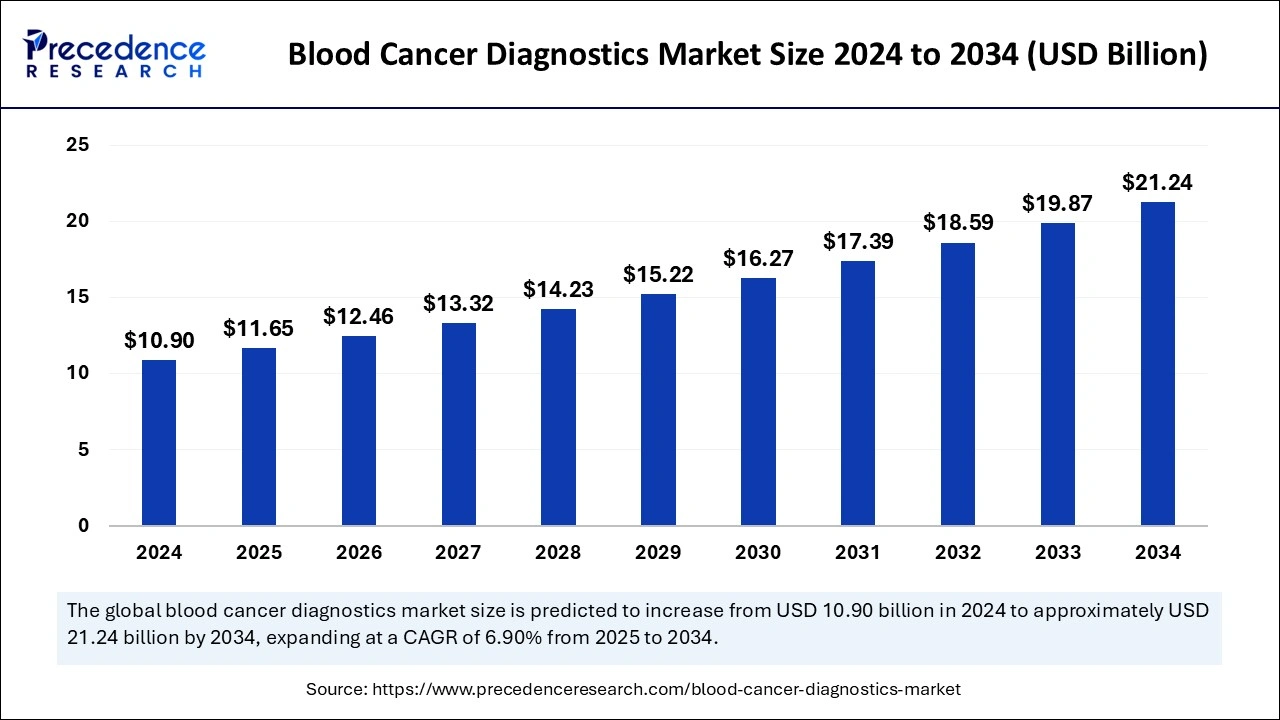
In recent years, the rapid evolution of health digitalization through Artificial Intelligence has brought a transformative impact in the field of cancer diagnostics and has shown promising results in the diagnosis of several different types of human cancers. The use of AI integration in the blood cancer diagnostics market presents an immense opportunity for better cancer detection and improved patient outcomes. In its initial stages, early detection can improve cancer outcomes by identifying the disease.
AI plays a vital role in medical imaging for early cancer detection, utilizing deep learning algorithms for image recognition and feature extraction. Harnessing the power of AI, particularly in tools like computer-aided diagnosis, has great potential to revolutionize early cancer detection. This technology provides improved accuracy, speed, precision, and sensitivity, which brings significant progress in accurate cancer diagnosis, treatment, and management. Therefore, the application of AI in cancer diagnostics can improve patient outcomes and reduce cancer mortality rates.
The U.S. global blood cancer diagnostics market size was exhibited at USD 4.56 billion in 2024 and is projected to be worth around USD 9.04 billion by 2034, growing at a CAGR of 7.08% from 2025 to 2034.
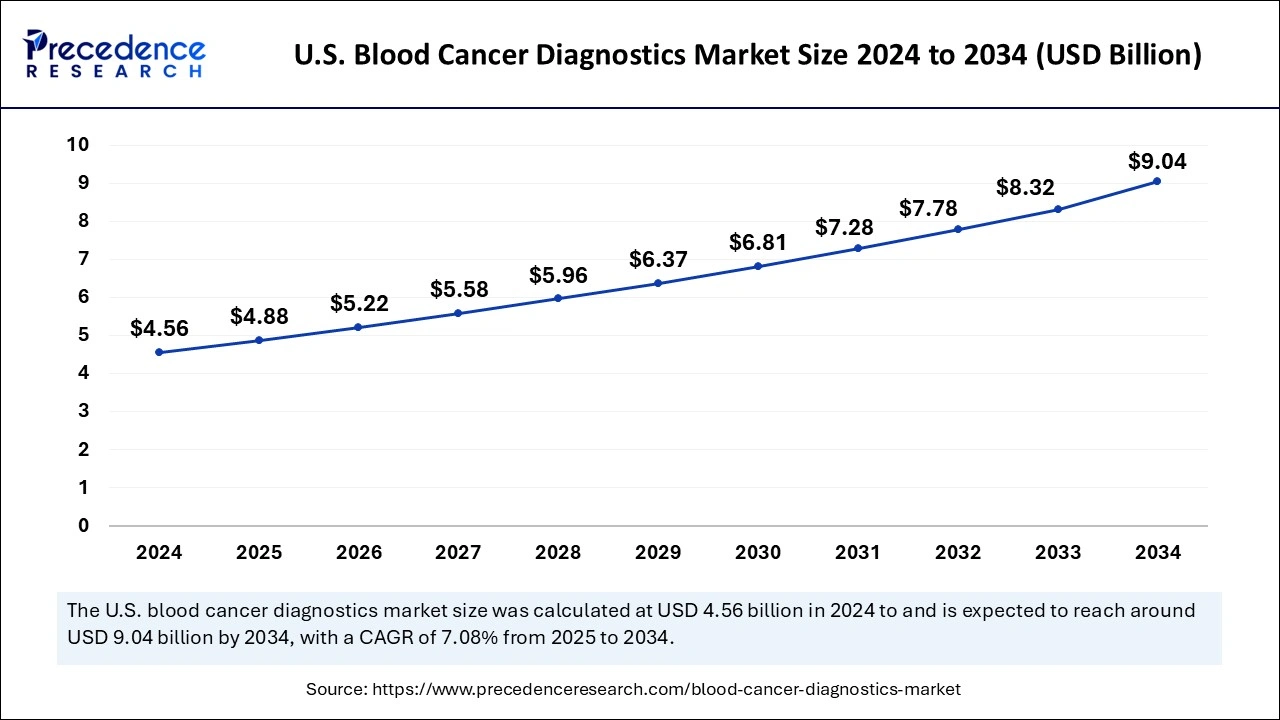
North America held the dominant share of the blood cancer diagnostics market in 2024. The growth of the region is attributed to the presence of sophisticated healthcare facilities, rising incidence of blood cancers such as leukemia, lymphoma, and multiple myeloma, rising private and public investments to enhance the infrastructure to support blood cancer diagnosis, rising R&D studies and trials, and rising awareness regarding early screening programs. In addition, technological advancements in diagnostic tools and techniques such as positron emission tomography (PET), NGS testing solutions, molecular testing, liquid biopsy, flow cytometry, and others are anticipated to promote regional growth during the forecast period.
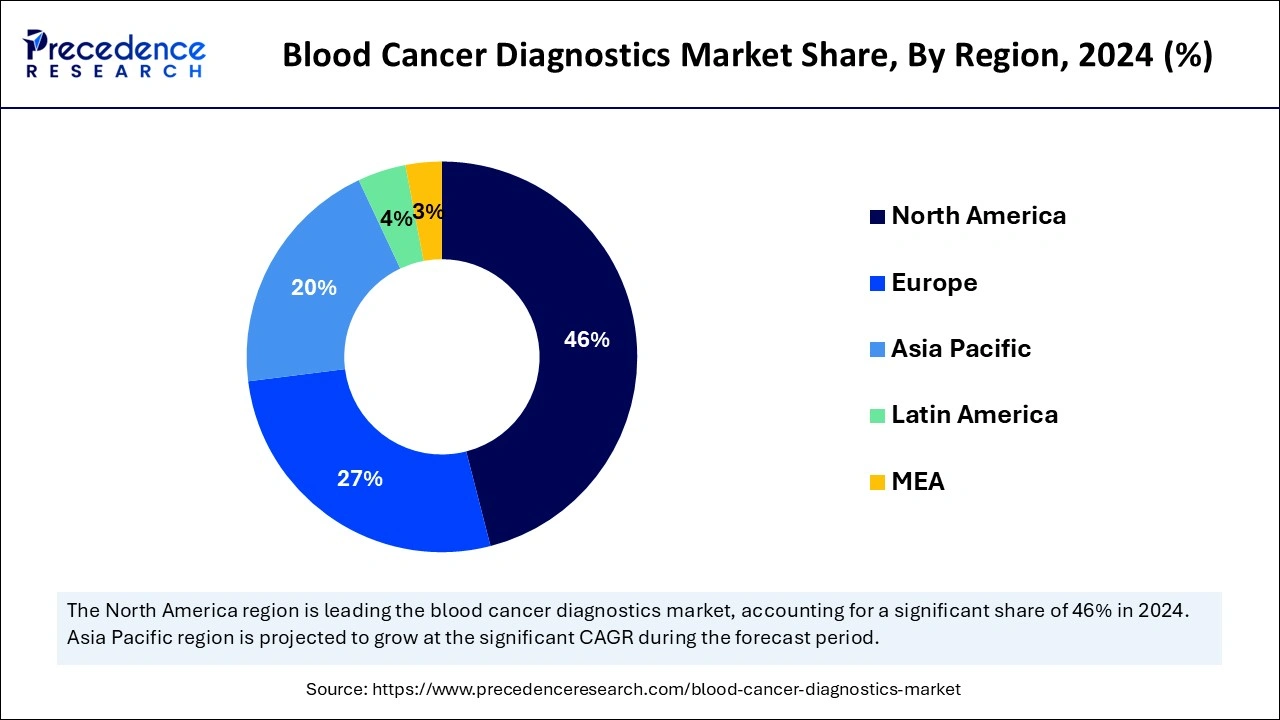
On the other hand, Europe is observed to expand at a rapid pace in the blood cancer diagnostics market during the forecast period owing to the rising prevalence of blood cancers, rising awareness of early diagnosis of symptoms for better treatment outcomes, rapid technological advancement in diagnostic methods, and government entities advocating for routine screenings and early diagnoses. The region's extensive range of advanced diagnostic facilities, along with skilled professionals and treatment options, allows the development of personalized treatment plans that cater to each patient's unique needs.
The blood cancer diagnostics market includes several advanced diagnostic tests and techniques to diagnose and detect various human blood cancers. These tests may include blood tests, imaging tests, biopsy, and molecular tests. There are three major types of blood cancers: leukemia, lymphoma, and multiple myeloma. Each type begins in the bone marrow or blood when these cells fail to grow normally. Accurate and efficient diagnostic testing is widely utilized to confirm the presence of diseases and monitor the disease's progression.
| Report Coverage | Details |
| Market Size by 2034 | USD 21.24 Billion |
| Market Size in 2025 | USD 11.65 Billion |
| Market Size in 2024 | USD 10.90 Billion |
| Market Growth Rate from 2025 to 2034 | CAGR of 6.90% |
| Dominating Region | North America |
| Fastest Growing Region | Asia Pacific |
| Base Year | 2024 |
| Forecast Period | 2025 to 2034 |
| Segments Covered | Product, Test, End Use, and Regions. |
| Regions Covered | North America, Europe, Asia-Pacific, Latin America, and Middle East & Africa |
Rising demand for blood cancer diagnostic tests
The growing demand for blood cancer diagnostic tests is expected to drive the growth of the blood cancer diagnostics market during the forecast period. The surge in blood cancer diagnostic tests is majorly driven by the increasing prevalence of leukemia, lymphoma, and multiple myeloma across the globe. Blood cancer has become a major health concern, often resulting from aging, genetic and environmental factors. Leukemia is one of the most common types of blood cancer worldwide. The diagnostic techniques for blood cancer include imaging tests such as X-rays, CT scans, Magnetic Resonance Imaging (MRI), biopsies such as bone marrow biopsies, lymph node biopsies, and blood tests.
According to the data released by the World Health Organization (WHO) cancer agency, the International Agency for Research on Cancer (IARC), in February 2024:
High cost
The high cost associated with blood cancer diagnostic tests is anticipated to hamper the market's growth. In addition, the absence of skilled professionals and inadequate healthcare facilities in middle and lower-income countries may restrict the expansion of the global blood cancer diagnostics market.
Rapid technological advancement
The rapid technological advancement is projected to offer lucrative opportunities to the blood cancer diagnostics market during the forecast period. Several market leaders are developing new and innovative diagnostic techniques and tests to improve the speed, precision, and accuracy of blood cancer diagnosis. The advanced diagnostics of blood cancer encompasses a wide range of tests and procedures designed to diagnose, detect, and monitor the disease affecting the blood, bone marrow, and lymphatic system. The early detection of cancer becomes essential to ensure that the rate of treatment success is up and mortality is reduced. Technological advancements, including NGS and other molecular diagnostic techniques, are improving the efficiency and accuracy of blood cancer diagnosis.
The assay kits and reagents segment accounted for the dominating share of the blood cancer diagnostics market in 2024, owing to the rising demand for accurate and rapid diagnostic tests. Assay kits & reagents are widely used to detect specific biomarkers, genetic mutations, and other indicators, assisting healthcare specialists in more effectively diagnosing and treating the disease. In addition, the rapid technological advancements and several strategic initiatives by the several manufacturers, such as expansion, product approvals, and collaboration, to develop these kits & reagents provide a wide range of products that serve the diverse diagnostic needs of patients.
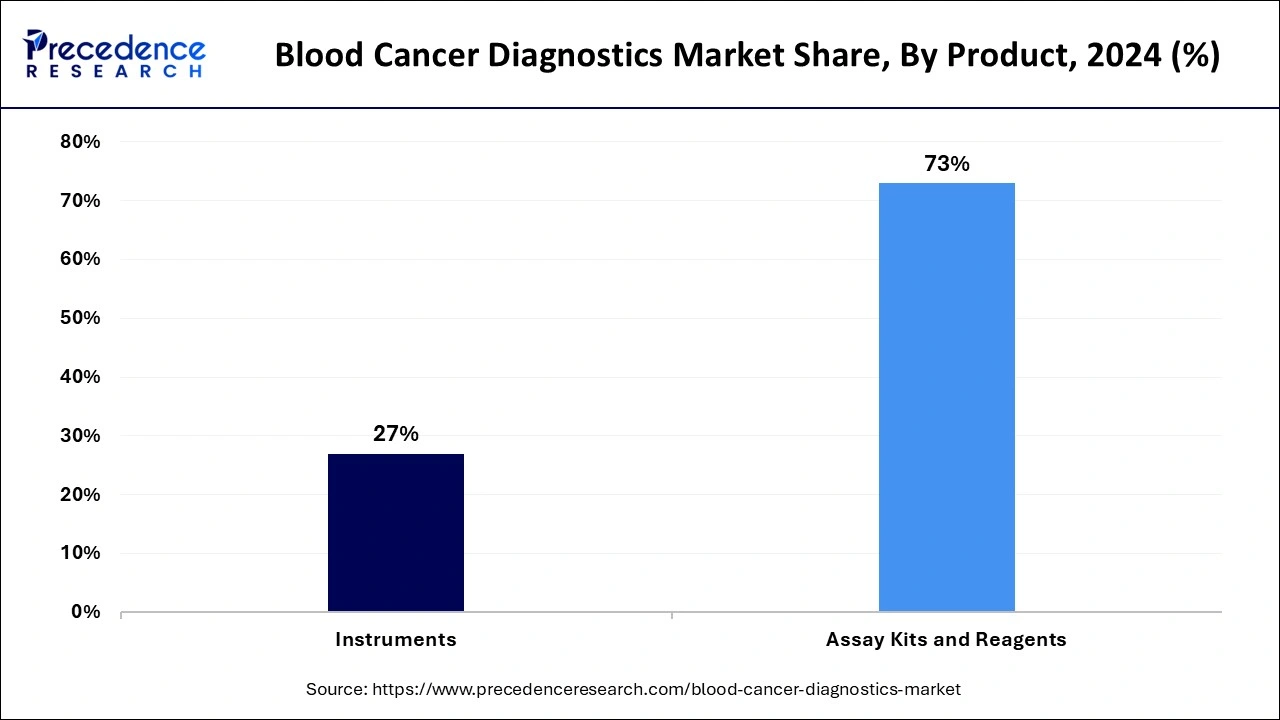
On the other hand, the instruments segment is expected to witness significant growth during the forecast period. Instruments play a vital role in the accurate detection and monitoring of blood cancers, including lymphoma, leukemia, and multiple myeloma. In addition, molecular diagnostic instruments, including PCR machines and NGS systems, serve as important resources for identifying genetic abnormalities associated with blood cancers, which also accelerates the development of personalized treatment strategies.
The blood tests segment dominated the blood cancer diagnostics market in 2024 and is projected to continue its dominance over the forecast period. The growth of the segment is majorly driven by the rising incidence of blood cancers, which increases the demand for early and accurate diagnosis of blood tests. CBC tests can detect abnormalities in blood cell counts and indicate the presence of blood cancer. Moreover, the improvement of specialized blood tests, including multicancer detection, has significantly transformed the diagnosis and monitoring of blood cancers.
On the other hand, the molecular test segment will witness considerable growth over the forecast period. Molecular tests have substantially revolutionized the diagnosis of blood cancers. Molecular tests analyze blood samples to detect genetic abnormalities, proteins, or other molecules. These tests can help diagnose cancer, plan treatment, and monitor treatment response. In addition, techniques including Fluorescence in Situ Hybridization (FISH), PCR, and NGS are extensively used to identify gene mutations, chromosomal translocations, & gene rearrangements characteristic of certain blood cancers. Thus, molecular tests assist in the diagnosis and management of blood cancers and empower researchers and clinicians to effectively diagnose blood cancer, prepare plans for treatment, and monitor treatment response.
The hospitals and clinics segment held the largest share of the blood cancer diagnostics market in 2024, and this segment is expected to sustain its position throughout the forecast period. The rapid growth of the segment is majorly driven by the rising acceptance and value of advanced cancer diagnostics in hospitals. The increasing developments in the laboratories of cancer care hospitals play a vital role in meeting the evolving needs of patients, and hospitals aim to provide a wide range of advanced diagnostic services in their settings. The major benefit offered by hospitals is the ability to perform cancer diagnoses and offer tests and results even in emergencies. Hospitals are incorporating advanced diagnostic technologies to enhance the precision and accuracy of blood cancer detection. This surge in the investment in groundbreaking diagnostic equipment and rising focus on early detection and personalized treatment plans for better treatment outcomes.
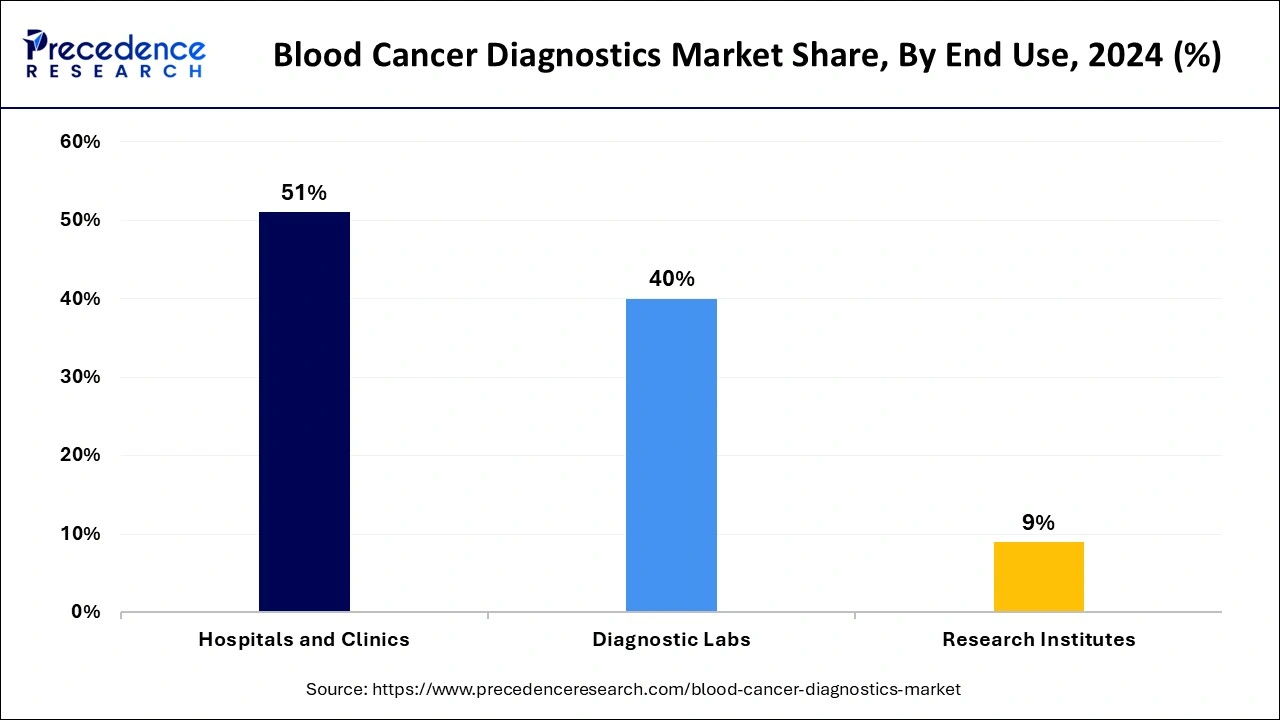
On the other hand, the diagnostic labs segment is expected to grow significantly during the forecast period owing to the rising testing and the presence of cutting-edge technologies for conducting tests. Moreover, the increasing volume of diagnostic tests conducted in diagnostic labs, coupled with the rising demand for testing instruments, is expected to propel the market demand during the forecast period.
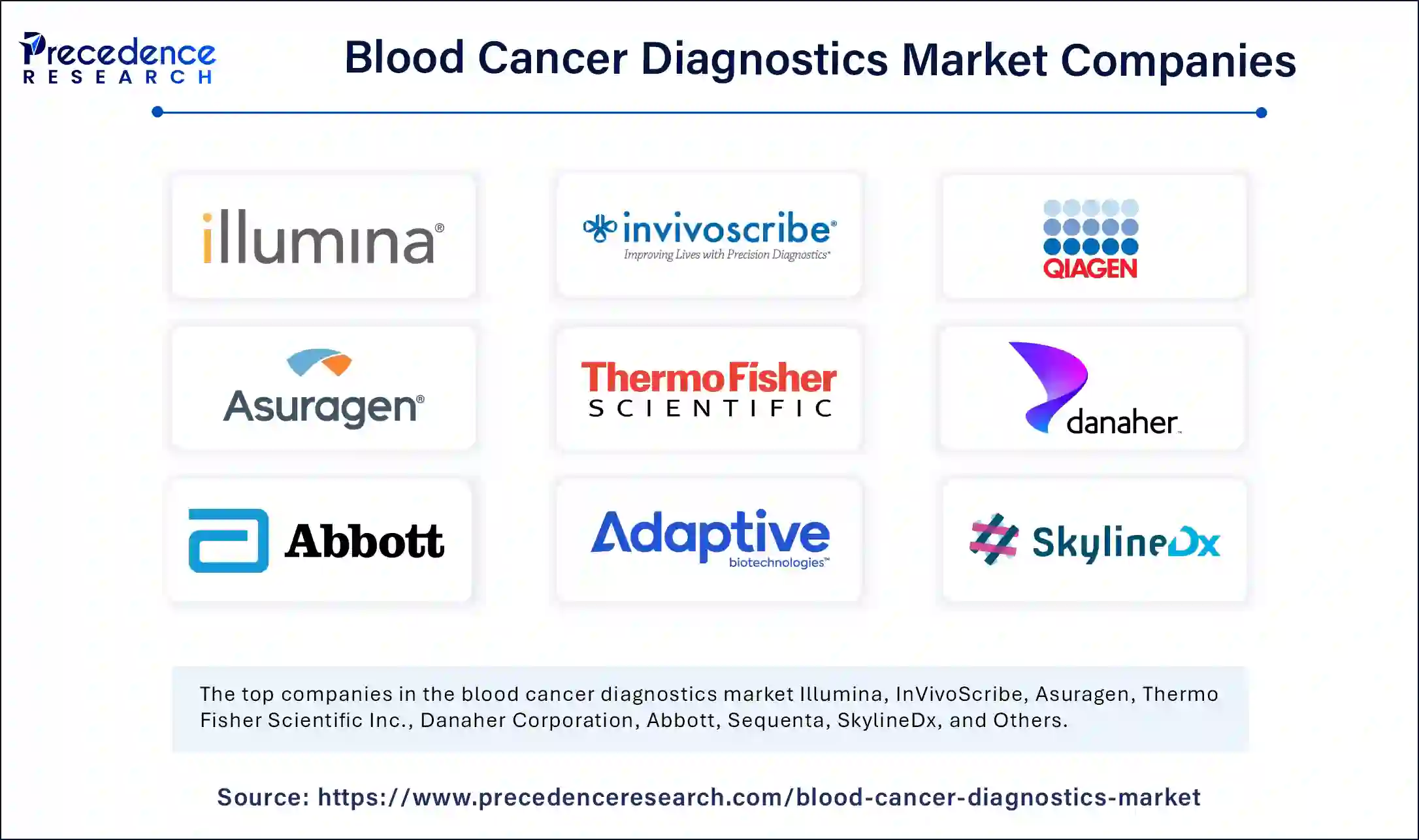
By Product
By Test
By End Use
By Geography
For inquiries regarding discounts, bulk purchases, or customization requests, please contact us at sales@precedenceresearch.com
No cookie-cutter, only authentic analysis – take the 1st step to become a Precedence Research client
April 2025
January 2025
August 2024
March 2024